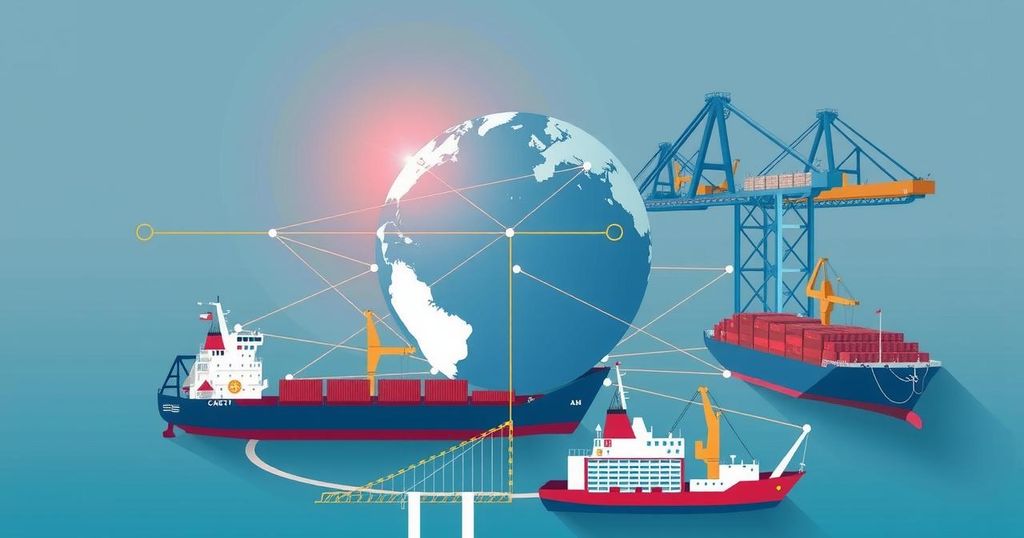President Donald Trump’s tariffs on Canada, Mexico, and China seek to reshape international trade relations but may lead to inflation and higher consumer prices. Tariffs act as import taxes intended to protect U.S. industries but often result in increased costs borne primarily by consumers. The economic impacts are debated, with potential consequences on various consumer goods and overall market stability.
The recent tariffs imposed by President Donald Trump on Canada, Mexico, and China manifest a robust maneuver impacting America’s primary trading partners, but they raise concerns regarding inflation and potential disruptions within the global economy. Trump asserts such tariffs serve to leverage the United States’ financial power to redefine trade norms. However, the impact on consumer prices and financial stability remains uncertain, and market reactions following the announcement indicate apprehension within economic sectors.
Tariffs, essentially taxes levied on imports, aim to deter American businesses from sourcing goods from nations like China by increasing the cost of these products. These fees, typically collected by Customs and Border Protection, range from 2.5% for passenger cars to as high as 6% for golf shoes. With trade agreements often exempting specific goods from tariffs, the current measures will likely affect a wide array of items across numerous categories.
Contrary to the belief that foreign countries bear the tariff costs, it is primarily American importers and ultimately consumers that face the financial burden. Research demonstrates that tariffs lead to increased prices for various goods, thereby disproportionately impacting lower-income households. For example, the Peterson Institute for International Economics estimates that universal tariffs could cost the average U.S. household significantly, with projections of up to $2,600 annually under certain conditions.
The imposition of tariffs will likely affect numerous consumer products — from toys and furniture to vehicles and foods. Experts predict substantial price rises, noting that approximately 80% of toys sold in the U.S. are manufactured in China, potentially leading to cost increases of over 50% for some products. Likewise, imports from Mexico and Canada may cause price hikes in various sectors including automotive and food industries.
Historically, tariffs have been used as tools not only for revenue generation but also for protecting domestic Industry and enforcing fair trade practices. The debate surrounding tariffs has evolved, particularly since they accounted for a significant portion of government revenue in the 19th century. Nonetheless, recent economic analyses have suggested that the anticipated benefits may be countered by retaliatory tariffs from affected nations and possible increases in inflation rates.
While TikTokers may appreciate the perceived protective aspect of tariffs, potential retaliations may ultimately negate these benefits, as seen in prior instances of tariff-enforced trade wars. Furthermore, Trump’s administration endeavors to leverage tariffs to negotiate favorable international trade agreements while mitigating illegal immigration. The economic implications of these tariffs, however, remain contentious, with studies revealing that they did not yield the intended job recovery in manufacturing sectors.
Finally, the National Retail Federation suggests that the cumulative effects of these tariffs may result in an average cost increase for American households between $2,045 and $7,600 annually. The risks of inflation are pronounced amid these tariff measures, particularly concerning essential imports such as oil and gas from Canada, which could lead to heightened consumer prices unless specified exemptions are made.
The current discussion on tariffs primarily revolves around President Donald Trump’s imposition of trade penalties on key economic partners: Canada, Mexico, and China. These tariffs, which include a 25% charge on imports from North America and a 10% tax on Chinese goods, aim to reassert U.S. control in international trade and address issues such as illegal immigration and drug trafficking. The anticipated consequences involve inflationary pressures on consumer prices, prompting widespread concern across financial markets and among economists regarding the stability of global trade relationships.
In summary, the tariffs established by President Trump against Canada, Mexico, and China could lead to increased consumer prices, economic instability, and inflation. While intended to strengthen domestic manufacturing and influence trade negotiations, the economic repercussions may disproportionately burden households, particularly those with lower incomes. The ultimate effectiveness of these tariffs remains uncertain as retaliatory measures loom and their impact on the consumer market unfolds.
Original Source: www.nbcchicago.com






